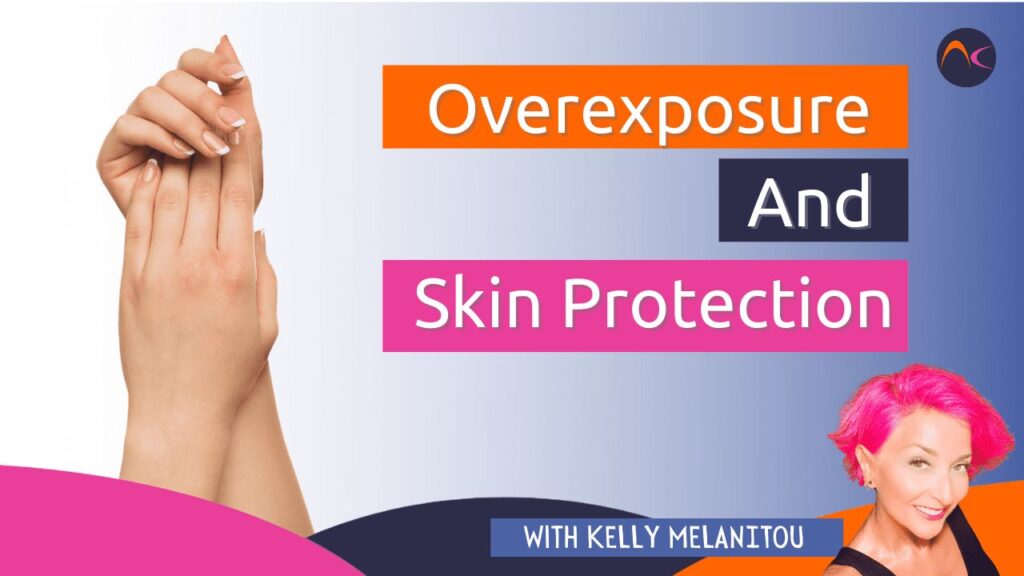I was browsing through social media last night and, somehow, I ended up watching a bunch of nail-related videos. I was shocked by how many times I saw product touching (or liberally being applied on) skin. And I am talking about products that should not be touching the skin at all, like UV gel, monomer liquid, etc. So today we are going to talk about overexposure and skin protection.
What is Overexposure?
Overexposure is prolonged (lingering) and/or repeated skin contact with such ingredients. Typically, products used in the nail salon are designed for application to the nail plate only. Nail professionals should understand and follow manufacturer’s guidelines to help avoid overexposing their skin and the skin of their clients. Some examples of nail products that may be potentially irritating include nail hardeners, adhesives, nail treatments, polishes, primers, as well as all types of UV gels, l&p, and resins. These are all designed to be applied to the natural nail ONLY. Skin contact should be avoided, since it may potentially cause skin irritation or allergy. That means that the skin may become red, swollen, dry, itchy, cracked, or even develop tiny water blisters.
Sometimes, we can see reactions from overexposure to things that we don’t even think about. For example, latex gloves can cause skin allergies. Overexposure (prolonged and repeated contact) to latex gloves for several months, or even years, can cause previously unaffected people to develop a persistent rash on the hands and wrists. In this case, sensitization is caused by naturally occurring proteins found in latex rubber that are acting as allergens.
Skin Protection is Important
The most important way to avoid overexposure is hand washing. Both the nail pro and the client should be washing their hands before and after each service. Properly wash hands by scrubbing for at least 20 seconds with a soft bristle scrub brush and mild liquid soap, thoroughly rinsing with warm water, then drying hands thoroughly. Allowing dust, sticky substances, etc. to remain on the skin for prolonged periods can increase the risk of developing skin irritation or allergy. If any product is spilled on clothing, then you should remove the clothing immediately, in order to avoid prolonged contact with the underlying skin.
The proper glove is another important way to protect the skin. I have already mentioned that many people develop allergies to latex. Additionally, latex and vinyl gloves are more permeable to many of the ingredients used in nail products. I believe that disposable nitrile gloves are the best choice for nail pros. And if someone is allergic to cornstarch, they should avoid powdered gloves. It is interesting to know that the FDA (the US Food and Drug Administration) actually banned powdered gloves since January 2017!
What else can we do?
We need to remember that we want to protect not only our clients but also ourselves from overexposure. We should avoid exposing hands to harsh cleaners, solvents, or disinfectants. These remove the natural oils from the skin, which leads to dryness. Skin that is dry or irritated becomes more susceptible to penetration of ingredients that would normally be unable to pass through the natural barrier of the skin’s surface.
Keeping containers, tabletops, clothing, tools, and implements clean is equally important. A leaky container or a contaminated brush handle can cause repeated skin exposure with each handing. Tabletops or towels contaminated with product residue or dust can be a source of overexposure, as well. Remember that paper towel where you wipe your brush when working with l&p? Make sure it stays away from your skin!
So let’s summarize:
- Have your client wash their hands thoroughly before and after each service, or if accidental skin exposure occurs, and you do the same yourself.
- Wear disposable nitrile gloves or the glove type recommended by the manufacturer of the products you use. Replace these gloves immediately if there are signs of cuts, tears, holes, or contamination.
- Choose clothing that covers and protects as much skin as possible, like fitted long-sleeved blouses and at least knee-length pants or skirts to help protect your lap.
- Keep products in small-sized containers at the worktable to reduce the risk of spills and minimize skin exposure. Make sure to close properly closing them when not using them.
- Avoid skin contact with disinfectants or harsh cleaners.
- If there are visible signs of sensitivity or allergic reaction to a product, stop using it immediately. Even better, consult with a physician.
- Understand and follow the manufacturers’ instructions and guidelines. Always ask for the SDS.
Stay safe!


